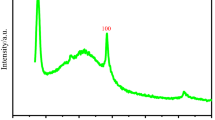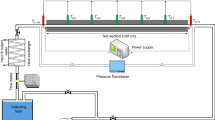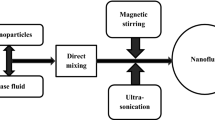Abstract
Aqueous graphene nanofluids having concentrations 0.01, 0.1, and 0.3 vol.% were used as heat transfer media during quenching of ISO 9950 inconel alloy probe. Contact angle measurements were carried out to assess the wettability of graphene nanofluids. Nanofluids showed better wettability compared to base water with over 16% reduction in their contact angles. The cooling performance of the quench media was assessed by cooling curve analysis during quenching of an instrumented inconel probe from 860 °C into the quench medium. Recorded temperature readings showed longer vapor phase stage during quenching with nanofluids. The severity of nanofluids was found to be lower relative to water. During quenching with nanofluids, the estimated spatiotemporal heat flux transients at the metal/quenchant interface showed that more heat was removed during the vapor phase stage of cooling. The present study brings out the possibility of using stable water-graphene nanoplatelet suspensions for quench heat treatment of steel components requiring cooling severity between water and oil/polymer quenchants.









Similar content being viewed by others
Abbreviations
- R a :
-
Average roughness value (µm)
- R z :
-
Average roughness depth (µm)
- Crmax :
-
Maximum cooling rate (°C/s)
- CR705 :
-
Cooling rate at 705 °C (°C/s)
- CR550 :
-
Cooling rate at 550 °C (°C/s)
- CR300 :
-
Cooling rate at 300 °C (°C/s)
- CR200 :
-
Cooling rate at 200 °C (°C/s)
- T maxcr :
-
Temperature at maximum cooling rate (°C/s)
- H :
-
Quench severity
- CR500-600 :
-
Average cooling rate from 500 to 600 °C (°C/s)
- q :
-
Unknown heat flux (MW/m2)
- γ lv :
-
Liquid-vapor interfacial surface tension (mN/m)
- θ :
-
Contact angle measured at the triple line (solid-liquid-vapor interface) (°)
- γ sv :
-
Solid-vapor interfacial tension (mN/m)
- γ sl :
-
Solid-liquid interfacial tension (mN/m)
- I vap :
-
Heat removed at the end of the vapor phase stage (MJ/m2)
- I max :
-
Heat removed at the maximum heat flux point (MJ/m2)
- I 20 :
-
Heat removed in the time period of 20 s during quenching (MJ/m2)
References
J. Grum, S. Bozic, and M. Zupancic, Influence of Quenching Process Parameters on Residual Stresses in Steel, J. Mater. Process. Technol., 2001, 114(1), p 57–70
C. Simsir and C.H. Gur, A Simulation of the Quenching Process for Predicting Temperature, Microstructure and Residual Stresses, Int. J. Mech. Eng., 2010, 56(2), p 93–103
G.E. Totten, C.E. Bates, and N.A. Clinton, Other Quenching Processes, 1st edn, Handbook of Quenchants and Quenching Technology, G.E. Totten, C.E. Bates, and N.A. Clinton, Ed., ASM International, Materials Park, 1993, p 293–304
S.B. Hassan, J.B. Agboola, V.S. Aigbodion, and E.J. Williams, Hardening Characteristics of Plain Carbon Steel and Ductile Cast Iron Using Neem Oil as Quenchants, J. Miner. Mater. Charact. Eng., 2011, 10(2), p 161–172
T. Korad, M. Polboon, N. Chumchery, and J. Pearce, Improving Quench Hardening of Low Carbon Steel, J. Met. Mater. Miner., 2011, 21(1), p 67–74
H.M. Tensi, Wetting Kinematics, Theory and Technology of Quenching, A Handbook, B. Lisic, H.M. Tensi, and W. Luty, Ed., Springer Science + Business Media, LLC, New York, 1992, p 96–97
K. Babu and T.S.P. Kumar, Effect of CNT Concentration and Agitation on Surface Heat Flux During Quenching in CNT Nanofluids, Int. J. Heat Mass Transfer, 2011, 54(1-3), p 106–117
G. Ramesh and K.N. Prabhu, The Effect of Addition of Copper Nanoparticles on Wetting Behaviour of Water During Immersion Quenching, Trans. Indian Inst. Met., 2013, 66(4), p 375–379
K.N. Prabhu and P. Fernades, Nanoquenchants for Industrial Heat Treatment, J. Mater. Eng. Perform., 2007, 17(1), p 101–103
G. Ramesh, K.N. Prabhu, Development of Clay Based Nanofluids for Quenching, Quenching Control and Distortion, Including the 4th International Distortion Engineering Conference, 1st edn., D.S. MacKenzie, B. Liscic, T. Lubben, H.W. Zoch, Eds., Sept 9-13, 2012 (Chicago), ASM International, 2012, p 308–318
J. Župan, T. Filetin, D. Landek, Cooling Characteristics of the Water Based Nanofluids in Quenching, International Conference on Materials, Tribology, Recycling, 1st edn., Z. Schauperl, S. Šolić, Eds., June 29-July 01, 2011 (Vela Luka, Croatia), Ministry of Science, Education and Sport, Croatian Society for Materials and Tribology, 2011, p 575–584
H. Kim, J. Buongiorno, L.-W. Hu, and T. McKrell, Nanoparticle Deposition Effects on the Minimum Heat Flux Point and Quench Front Speed During Quenching in Water-Based Alumina Nanofluids, Int. J. Heat Mass Transf., 2010, 53(7-8), p 1542–1553
H.H. Khoshmehr, A. Saboonchi, and M.B. Shafii, The Quenching of Silver Rod in Boiling Carbon Nano Tube-Water Nanofluid, Int. J. Therm. Sci., 2014, 75, p 95–104
S.J. Kim, I.C. Bang, J. Buongiorno, and L.W. Hu, Study of Pool Boiling and Critical Heat Flux Enhancement in Nanofluids, Bull. Pol. Acad. Sci., 2007, 55(2), p 211–216
G. Ramesh and K.N. Prabhu, Wetting Kinematics and Spreading Behavior of Water Based Aluminium Nanofluids During Immersion Quenching, Heat Treat. Surf. Eng., 2013, 3(2), p 74–78
L. Zhang, L. Fan, Z. Yu, and K. Cen, An Experimental Investigation of Transient Pool Boiling of Aqueous Nanofluids with Graphene Oxide Nanosheets as Characterized by the Quenching Method, Int. J. Heat Mass Transf., 2014, 73, p 410–414
R.N. Penha, L.C.F. Canale, G.E. Totten, G.S. Sarmiento, and J.M. Ventura, Simulation of Heat Transfer and Residual Stresses from Cooling Curves Obtained in Quenching Studies, J. ASTM Int., 2006, 3(5), p 1–14
T.S.P. Kumar, A Serial Solution for the 2-D Inverse Heat Conduction Problem for Estimating Multiple Heat Flux Components, Numer. Heat Transf. Part B, 2004, 45(6), p 541–563
G. Ramesh and K.N. Prabhu, Effect of Thermal Conductivity and Viscosity on Cooling Performance of Liquid Quench Media, Int. Heat Treat. Surf. Eng., 2014, 8(1), p 24–28
S.U.S. Choi, Nanofluid Technology: Current Status and Future Research, Korea-U.S. Technical Conf. on Strategic Technologies, October 22-24, 1998 (Vienna, VA), University of Chicago, 1999, p 26
M.J. Assael, C.F. Chen, I. Metaxa, and W.A. Wakeham, Thermal Conductivity of Suspensions of Carbon Nanotubes in Water, Int. J. Thermophys., 2004, 25(4), p 971–985
Acknowledgment
One of the authors (KNP) thanks the Science and Engineering Research Board (SERB), Department of Science and Technology (DST), New Delhi, India for the Research Grant.
Author information
Authors and Affiliations
Corresponding author
Rights and permissions
About this article
Cite this article
Nayak, V.U., Prabhu, N.K. Wetting Behavior and Heat Transfer of Aqueous Graphene Nanofluids. J. of Materi Eng and Perform 25, 1474–1480 (2016). https://doi.org/10.1007/s11665-016-1962-2
Received:
Revised:
Published:
Issue Date:
DOI: https://doi.org/10.1007/s11665-016-1962-2




